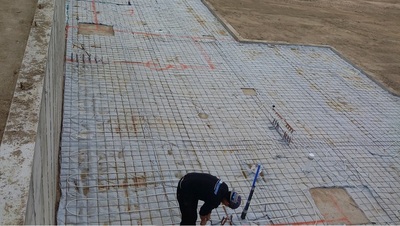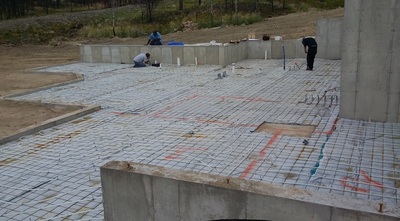Hydronic Radiant Heat Systems
|
Imagine having the best heating system you could ask for in your home. This system would be one you didn’t ever realize is there. Say goodbye to noisy radiators clanking in the middle of the night. Ditch the vents that remind you of a plane preparing for takeoff. And say Hello to an even blanket of heat right where you want it. So what is the big appeal of radiant floor heating? It's truly invisible and silent! A radiant floor system has more than just aesthetics going for it; it's also a highly efficient way to heat your house increasing comfort as it reduces allergies and energy costs. |
|
Why Choose Radiant Heat?
Radiant heat is without a doubt the most comfortable heat you will ever experience! We here at Team Plumbing are such fans of radiant heat that we have a hydronic system installed in our office and warehouse. After installing numerous hydronic radiant heat systems in homes around Colorado Springs in the 90’s, it was clear to us that a radiant heat system would be a superb addition to the new office building we had built back in 2004. Ten years later, we are still thrilled with the results we receive no matter how cold the weather gets outside.
Radiant heating systems have been a staple in Europe for decades now. Team has had many clients who have lived and traveled abroad come back to the states and request a radiant system installed when remodeling or building a new home. Once a person has lived in a home with a radiant heating system, it is rare that they ever go back to any other type of heating system for their home.
In a radiant system, the heat is supplied by hot-water tubes hidden underneath the floor. As the invisible waves of thermal radiation (aka HEAT) rise from below, they warm up any objects they make contact with. These objects then give off that captured heat. Even though the air temperature remains constant, you stay comfy because the surrounding surfaces aren't stealing warmth from you.
Compare radiant heat with a conventional forced-air heating system found in the majority of American homes. Air blows out of the registers at roughly 120 degrees, it then rises to the crown of the room where it quickly sheds heat and proceeds to sink back down. The air in the room can soak your head in warmth while your toes lounge in the cold. There is also the dilemma of circulation. When you turn on the furnace, it quickly takes you to 68 or 70 degrees and proceeds to shut off. Those harsh ups and downs are gone with radiant heating systems. With radiant heat, the warm air still rises, but it does so evenly over the entire floor, so the coolest air stays up at the ceiling.
Hot-water "hydronic" systems are the most popular and cost effective way to heat an entire house. The flexible tubes that carry hot water from a boiler or hot water heater can be installed in a variety of ways; on top of the subfloor in grooved panels, clipped into strips on the underside of the floor; or embedded in poured concrete. When the system is in place, you can cover it with most types of finish flooring.
Radiant heat dates to ancient times, when the Romans warmed rooms by running wood-burning fires under elevated marble floors, keeping toes and togas nice and toasty. Many centuries later, in this country, Frank Lloyd Wright buried copper pipes in the concrete floors of his homes and warmed them with hot water. Today, plastic PEX tubing has replaced metal as the favored means of feeding hydronic heat into floors, making radiant more affordable than ever. And with a no-fail track record in Europe going back more than 35 years, it's also made them more reliable.
Radiant heating systems have been a staple in Europe for decades now. Team has had many clients who have lived and traveled abroad come back to the states and request a radiant system installed when remodeling or building a new home. Once a person has lived in a home with a radiant heating system, it is rare that they ever go back to any other type of heating system for their home.
In a radiant system, the heat is supplied by hot-water tubes hidden underneath the floor. As the invisible waves of thermal radiation (aka HEAT) rise from below, they warm up any objects they make contact with. These objects then give off that captured heat. Even though the air temperature remains constant, you stay comfy because the surrounding surfaces aren't stealing warmth from you.
Compare radiant heat with a conventional forced-air heating system found in the majority of American homes. Air blows out of the registers at roughly 120 degrees, it then rises to the crown of the room where it quickly sheds heat and proceeds to sink back down. The air in the room can soak your head in warmth while your toes lounge in the cold. There is also the dilemma of circulation. When you turn on the furnace, it quickly takes you to 68 or 70 degrees and proceeds to shut off. Those harsh ups and downs are gone with radiant heating systems. With radiant heat, the warm air still rises, but it does so evenly over the entire floor, so the coolest air stays up at the ceiling.
Hot-water "hydronic" systems are the most popular and cost effective way to heat an entire house. The flexible tubes that carry hot water from a boiler or hot water heater can be installed in a variety of ways; on top of the subfloor in grooved panels, clipped into strips on the underside of the floor; or embedded in poured concrete. When the system is in place, you can cover it with most types of finish flooring.
Radiant heat dates to ancient times, when the Romans warmed rooms by running wood-burning fires under elevated marble floors, keeping toes and togas nice and toasty. Many centuries later, in this country, Frank Lloyd Wright buried copper pipes in the concrete floors of his homes and warmed them with hot water. Today, plastic PEX tubing has replaced metal as the favored means of feeding hydronic heat into floors, making radiant more affordable than ever. And with a no-fail track record in Europe going back more than 35 years, it's also made them more reliable.









